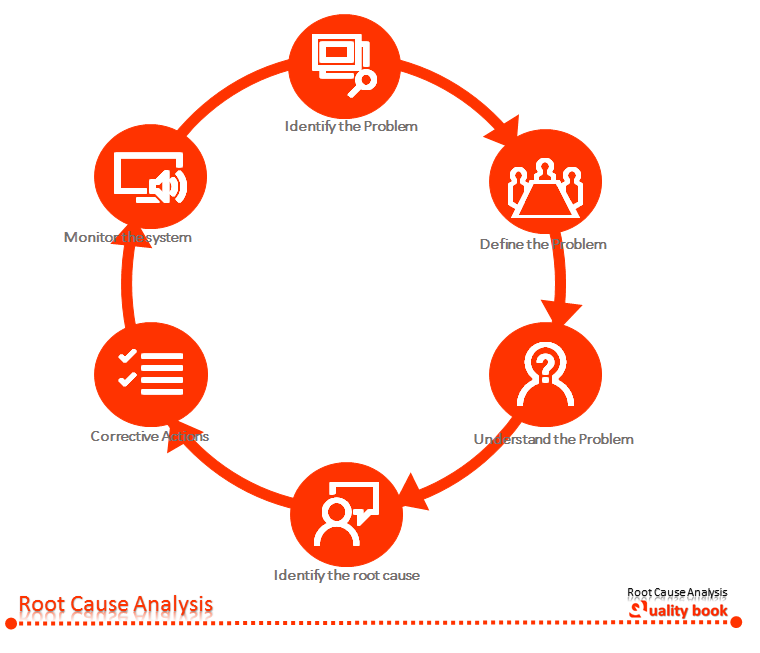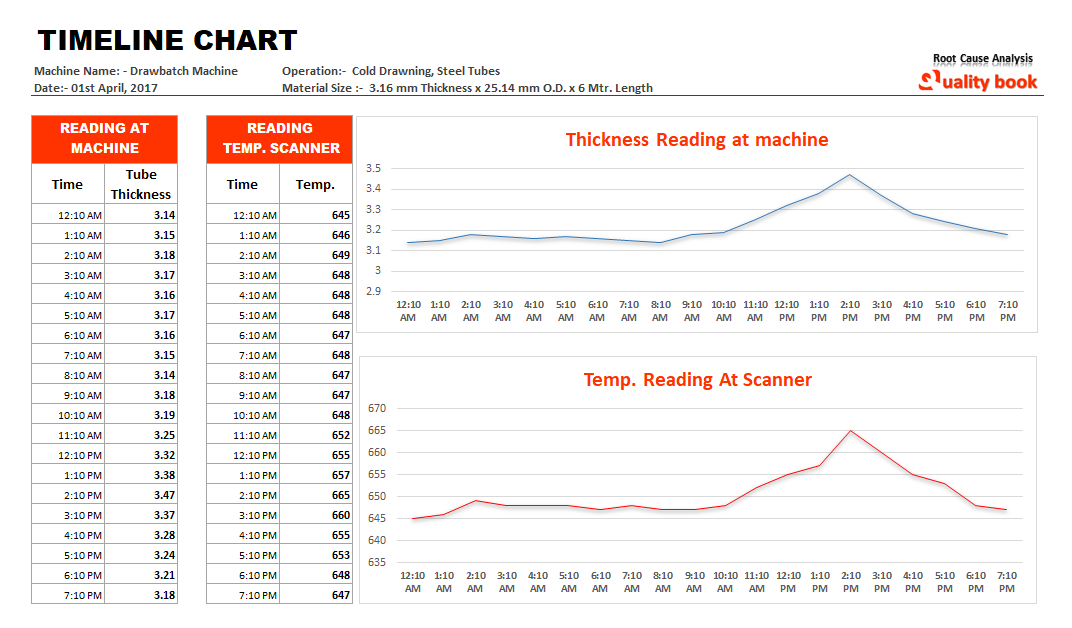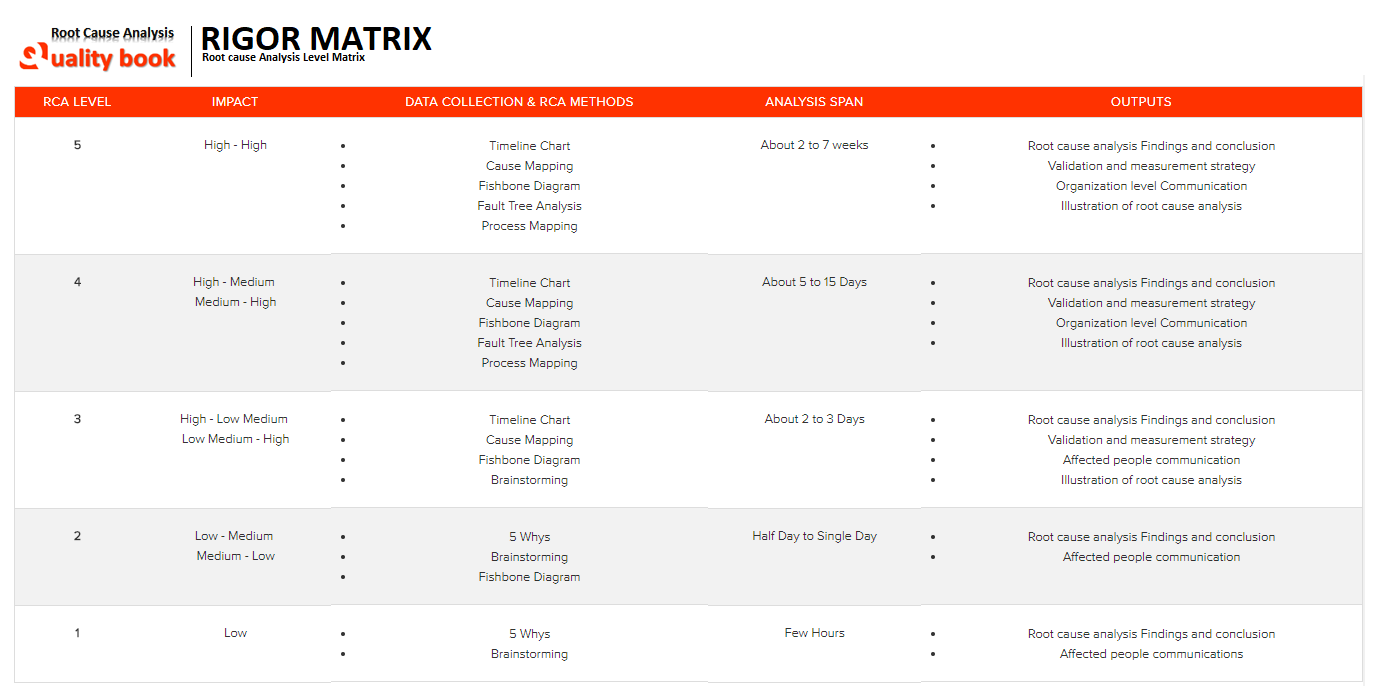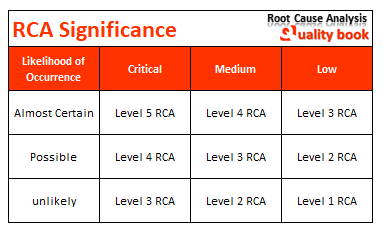What is root cause analysis? || When should Root Cause Analysis be performed? || Symptom Approach Vs. Root Cause Approach table || Root cause analysis process ||
When you are dealing with lots of machinery, equipment and involvement of human obviously cause raise problem on any process or any location. We can eliminate, prevent, and isolate issues through planning and preventive actions which are raise by expected causes, but due to some special causes or unexpected reasons some problems can appear in regular processes, needs specific techniques to eliminate and prevent it. Fortunately, since decade we have some analytical methods are widely used worldwide by successful implementation for elimination of appropriate problems and that is Root Cause Analysis (RCA).
What is Root cause analysis?
Root Cause Analysis (RCA) is a method for identifying the basic factors of the problem underlying a variation in processes.
The root cause analysis or technique is a depth method for identify the basic factors underlying a problem. Which can be managed by focus on existing systems and processes. Generally, definition of the root cause analysis (RCA) is a method or tool used to re-actively. To inspect a negative impact case that already has occurred, and proactively. To analyze and improve processes and systems before they damage.
In short, this is straightforward method designed for identify and determine relationship between incident and issues that may have combined to produce the significant problems.
When should Root Cause Analysis be performed?
- During performing any specific process, it is possible repetitive human errors are occurred, or equipment failures associated with manufacturing processes.
- Found Involvement of any surprise risk event during processes.
- Process failure during performing manufacturing activities, and production stoppage.
- Resources / Asset damage or loss
- Quality degradation / or customer dissatisfaction, that is performance is generally below expected standard.
The root cause analysis (RCA) is a method or technique that widely used in manufacturing industry to conduct effective actions to addressing problems / non-conformance, by identify root cause of the problem. To identifying all the possible failures in a manufacturing processes and its design. You have to organize step by step process such as key processes and steps, inputs, outputs to identify which part of the process or inputs go wrong. As well as what is the impact on the outputs. Causes the potential failure, occurrence of failure and required prevent the failure in in existing controls usually conducts in the root cause analysis.

As you see above is state this point of simplicity of root cause analysis. Root cause analysis is the straightforward technique can apply of a series of well known, common sense methods which can generate systematic and documented approach to understand. Identify and resolute of underlying basic factors. Insufficient performance on the identification of symptoms of the problems and root causes is only wasting of resources & time.
See table below explain how system approach and root cause approach are differently works and impacts:
Symptom Approach Vs. Root Cause Approach: Table
| ROOT CAUSE APPROACH | SYSTEM APPROACH |
|---|---|
| {1} Errors or non-conformances are only outcomes of defects in the system. People are only part of the process. | {1} Errors, Mistake or non-conformances are often a outcomes of peoples’ performing any task with negligence. |
| {2} With Root cause analysis approach, you have to find out “what really happening?” and identify the basic factors which are raising the mistakes, to implement mistake-proof system to avoid reoccurrence. | {2} With System Approach, We through peoples needs more training and motivation to be more careful in appropriate tasks. |
| {3} With Root cause analysis Approach, every single problem is critical and needs to fix it by corrective and preventively to avoid reoccurrence. | {3} With system approach, we are not conducting dept analysis or argue that we don’t have the time or resources to really get the dept of this issue. |
Root cause Analysis Process
Generally, the analysis to determine root causes initiate begins with single analyst for most common problems. But if you deal with complex problems needs team and proper development to collect and analyze information.
Here as below simple root cause analysis process steps given for systematic approach:
- Organize team
- Define problem or issue
- Conduct data analysis
- Determine root cause (s) & implementation
- Implement permanent corrective actions & Check effectiveness
To Improvement of overall efficiency of the manufacturing processes and cost control, required to minimize or eliminate issues on floor level to maintain smooth production lines. By effective monitoring system helps to identify and measure effect of a problem and reducing what has caused it to occur. Creating sufficient action plan for prevention that should put an end to the problem permanently.
[ 1 ] Organize team
The established team should be multidisciplinary, and may team members from cross functional areas i.e. manufacturing, engineering, quality etc.
Because to solve any specific issue require every member having multiple expertise at on every level. Generally, the team members of the investigation team, are selected by on senior leader ship based, or as expertise on subject, or expert with effected area.
However, selection of leader is always challenges and critical to the success of the root cause analysis investigation. The ideal candidate with vast experience is always prior on selection in leading root cause analysis, and bring a diverse team on technical issues.
Root Cause Analysis – Team management Process Map: Table
OBJECTIVESThe objective of team for the root cause analysis, is to identification of the different factors and transitions involves in processes and concern parties. That may have an influence on the corrective action processes. Such as organization, customers, suppliers, contractors etc. |
WHAT:Build a team representing from different functions and criteria that may have influence on the issues and that are require to prepare for help in its resolution. |
WHY:Cross functional team works multidisciplinary. By the team, root cause analysis is always more successfully conducted by team knowing the process and owning the data, than by individuals. |
WHEN:When the team identify and trace any symptoms, as soon as possible is should be consider as justifying a root cause analysis. |
HOW:Identify representatives from functions that may contribute to the corrective action process. Including identification of the root causes. See the points which are considerable for root cause analysis implementation:
|
OUTPUTS:Cross functional team of experts in place |
RESPONSIBLE:To improve the corrective action process, every one responsible including top management must support the team approach. The team leader must be empowered by the appropriate management level commensurate to the problem. Further, all the team members must be expertize in its own field. |
The leader must have authority to operator each activity independently of program management for root cause analysis as same responsible and accountable for arrangement and assignment of tasks to implement each phase of process. Each team member must be equally responsible and authorize to implement investigation process, verification and monitoring of process where incident occurred.
[ 2 ] Define problem or issue
It is important that, to develop a problem definition / statement. Which is directly address the problem that needs to be resolved. When establishing the problem statement.
The following elements should be considered:
- The team must define that what really happened, the statement requires to be specific, and stated in facts, preferably based on objective evidence.
- The specific location where did non-conformance identified, must exactly was the observed? In case of if the area of occurrence not be traced or easily isolated, then all the related locations among the last know good condition and the observed issues should be investigated.
- It is every one responsibility to implement root cause analysis. But the personnel who involved and observed the problems can help incise the facts surrounding the real observation. And helps to understanding the impact on future options for corrective actions.
- The team must identify the non-conformance identified in process is occurring how often by collecting data from effect area. The investigator can interview with personnel having experience with the affected machinery and process can aid in determining whether the event was a single time or reappeared.
- It is easy to collecting information from the affected area if the problem is repeating at same location, but in case of problem is not repetitive, needs to extra effort to resolve it. it is not easy to determine the root cause because of the insufficient information, frequency and other information related to problem will be limited. In those cases, needs to change in the resources, modification in the process sequences or alternative processes can helps to determine the effect on target task.
Root Cause Analysis – Define Problem – Process Map: Table
| OBJECTIVES To understand the importance, scale of problem and impact to enusre that situation is fully described. |
| WHAT: This phase of the process is assist to describe a problem and concern situation to get precisely analysis at all level again a common understanding of them, allowing defining an action plan. |
| WHY: In this stage you can detailing the problem on the document by proper way, subjective or even abstract. On the stage you can imagine that root cause analysis will not be identified and or insufficient actions cause failure. |
| WHEN: Immediate on all the related activities are done i.e. team formation is initial stage for root cause analysis. |
| HOW:You prepare the problem statement based on facts and figures instead of perception, it will supported objective evidence. Detailed focus on the symptoms which are experienced by the peoples and affected parties must covered scope and extent of the problem. |
| OUTPUTS: Defined problem, and team should agree on affective processes, product and defect or deviation. |
[ 3 ] Conduct data analysis
The collection of data and analysis is initial stage or requirement of any analysis. Hence the data collection must be planned & defined for appropriate subject. Cleared, data in order, easy language, and point to point details is always completed half of any work. Let’s see what further requirements for root cause analysis to conduct collection of data and analysis.
- The collection of data is initial requirement of analysis, should be specifically define and planned.
- Make the sure that the collection remains focused on requirements instead of wrong information and direction.
- The information must be captured the immediate environment information of an any issue / symptoms are seen at any location.
- The collection of data / information must be as solid plan defined to avoid misdirection & wasted time during an investigation. otherwise it can misguide and increase circumstances surrounding the problem.
- All the information should be in set of who, what, where, when, why and How must be specified.
- The collected information should clarify the occurrence and condition leading up to, during and immediately after a problem.
Data Collection & Classification: Table
| TOOL | WHEN TO USE |
|---|---|
| Check Sheet | When the collection of data required to maintain the frequency of the any process / event, issues and problems, defect reasons, mistakes and defects and affected area. |
| Control Charts | When required for predication of the expected range of results from a process. |
| Histograms | When got the result from a process, it needs to analyzing it by proper way. |
| Pareto Chart | When you have so many problems, and numbers of causes in the processes, and you want to concentrate on most significant issues and causes. |
| Scatter Diagrams | When we trying to determine the relationship between the two variables and such as when trying to identify potential root causes of problems. |
| Stratification | When the data information comes from several sources or situations like as daily basis, shift wise, suppliers etc. |
| Flow chart | For the better understanding of the sequences of processes done in produce the product. |
Timeline Chart for Root cause analysis
A detailed informative timeline of the full day events by timeline chart will assist for Identification of the failure in regular processes. The purpose of the timeline chart is to manage the sequences of event in single chart to understand the exact time & event to know the time and slab to compare clear view of situation, that will help to understand failure and basic factors underlying the problem. Sometime “5 Why” disable to identify real cause or misguided answers, or diverted in wrong direction, timeline chart will help to back on track by highlight the phase of process.
See the below example:

A time sequence of the any failure incident can be display by graphical structure for better and simple way of analysis. As you can see above image is an example of the detailed timeline for drawing process for the steel tubes displaying whole day history.
The chart (Thickness Reading) Showing between 10:10 AM to 6:10 PM, the variation in tube thickness recorded, hence during the same time slab temperature was raised dramatically.
[ 4 ] Determine root cause (s) & implementation
The improvement efficiency of manufacturing processes, prevent recurrence of problems, processes and resources failures must be adequately investigated, and identification of basic factors is necessary. The root cause had must properly understand in order to adequately identify and implement required actions including correction action, corrective actions and preventive actions.
The team must be understanding that the benefit of this Root cause analysis methodology is design and process improvement. Mostly we see in the investigation, there are almost always more than one root cause and that proximate or direct cause are not root causes.
To identify and confirm the root cause and recurrence of the problem required to determine by complexity, severity and likelihood of recurrence of the problem, you have to prepare the level of rigor matrix. You can merge the root cause analysis techniques and methods such as 5 why and brainstorming and if the problem is more complex that you can use cause & effect analysis as well as process mapping. So let’s see how to define and manage level of rigor matrix:
Root Cause Analysis (RCA) Rigor Matrix
| RCA LEVEL | IMPACT | DATA COLLECTION & RCA METHODS | ANALYSIS SPAN | OUTPUTS |
|---|---|---|---|---|
| 5 | High – High |
| About 2 to 7 weeks |
|
| 4 | High – Medium Medium – High |
| About 5 to 15 Days |
|
| 3 | High – Low Medium Low Medium – High |
| About 2 to 3 Days |
|
| 2 | Low – Medium Medium – Low |
| Half Day to Single Day |
|
| 1 | Low |
| Few Hours |
|
:: Rigor Matrix Image Download::


For the identification of the root causes, required focus on closely related performance concerns. Generally, reviews of personal interviews and findings of the reviews must be concentrated, other view focus on categories of factors that generally cause performance concerns. By using fishbone chart, possibility for explanations of causes will significantly increase and categorize like causes together.
Narrow the explanations to those that are actionable and go into deep to ensure the causes are root causes by using 5 Why method. Verify root causes with multiple data sources to ensure improvement strategies and action steps align. For the manage such things, you need to analysis tools are as below:
Root cause Analysis Tools & Techniques
- 5 Why
- Pareto Analysis
- Cause and Effect Diagram
- Flow Charts
- Fault Tree
- Check sheet
- Control Chart
As above mentioned all the tools and techniques are already detailed in previous topics, you can check and read the article to state used in analysis.
[ 5 ] Implement permanent corrective actions & Check effectiveness
Root Cause Analysis – Corrective Action Implementation Process Map: Table
| OBJECTIVES To ensure that, all the chosen corrective actions are implemented as defined & planned, and to assess their effectiveness in prevent undesirable situation from recurring. |
| WHAT: Keep the direction & implement all solutions that have been chosen. Verify effectiveness of all corrective action have been done as scheduled and that they will prevent and will contiue to prevent the unexpected event or recurrance. |
| WHY: To ensure that the verification of effectiveness of deployed corrective actions at appropriate location to ensure that the all corrective actions are properly implemented timely as defined plan. |
| WHEN: Generally, the implementation of corrective actions are conducted, on completion of selection & priotised actions. Hence the verification of effectiveness are conducted to planned the proper schedule for verification, or as on completion of process cycle to get the Actual data of further assurance. |
| HOW: Prepare plan detailed action, including work instructions, equipment and tools, etc. and establish review process, process audit, and comply remain requirements for implementation. |
| OUTPUTS: Permanent corrective actions implemented and efficiency |
| RESPONSIBILE: The owner of each action to implement it as defined and other team members including when relevant the customer, to verify effectiveness. |
Conclusion:
Remember that, the root cause analysis’s objective is to identify the Real Cause of problem, not the symptoms, fortunately, this tool will assist you to focus your efforts on the true root causes of escapes, so that truly prevent their re-occurrence.
- To prevent recurrence, you can use root cause analysis for actual / or near miss incidents.
- The collection of correct data completes half of your work, keep the approach outlined in this analysis.
- Make the documentation as straightforward as possible, to enhance the probability you will continue to use it in the future.
Ok, so begin the root cause analysis in your organization with positive energy, keep manage right information, follow up actions and review the corrective actions and prevent the reoccurrence. Best of Luck..